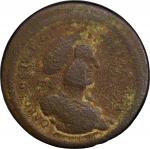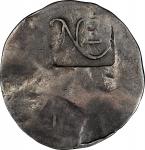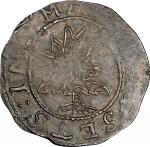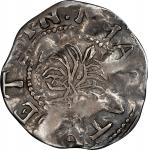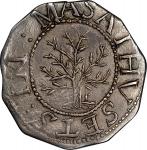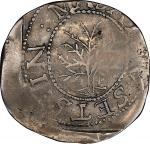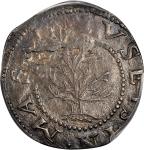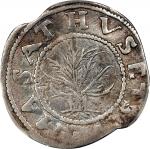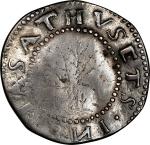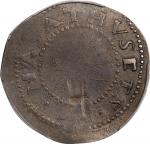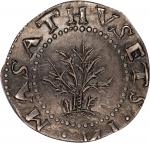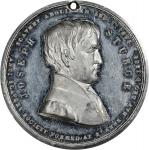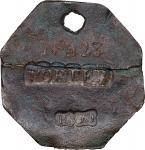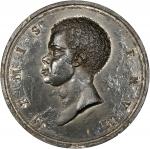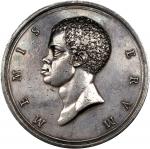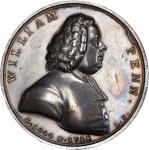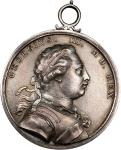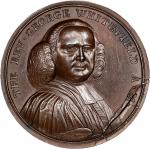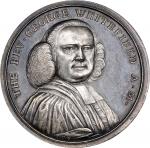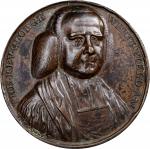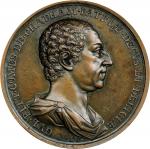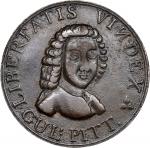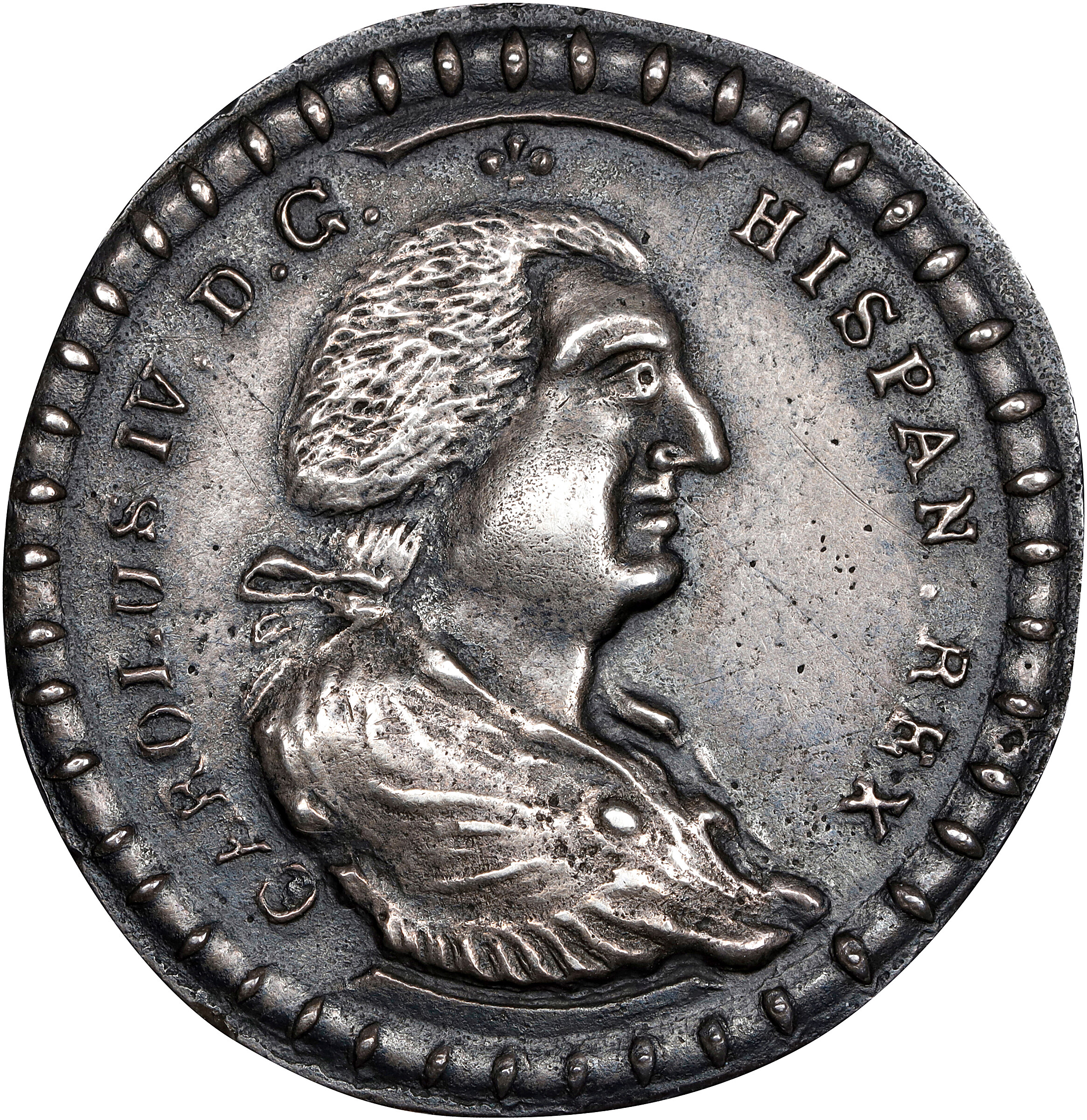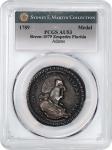1789 Zespedes Florida Proclamation Medal or Four reales. Herrera-133, Medina-148, Breen-1079. Silver, 32.2 x 33.7 mm. AU-53 (PCGS). 179.3 grains. Struck on a cast planchet. Last offered in our March 2015 sale, where we described it as follows:<p>One of just two pre-Federal numismatic issues associated with the modern state of Florida, likewise one of just two known Spanish Proclamation pieces issued on American soil that is known to have survived. A historically important colonial rarity, struck to commemorate the ascension of Carlos IV to the throne of Spain the same year that George Washington was inaugurated as the first president of the United States. Distributed in Saint Augustine, the capital of Florida Oriental, between December 2 and 4, 1789, this piece represented in metallic form Spanish control of their ancient American province that had been occupied by the English from the Treaty of Paris in 1763 until the second Treaty of Paris in 1783. The planchet is notably ovoid, like other known specimens of this rarity, measuring 33.7 mm on the longest axis from 1 oclock to 7 oclock and 32.2 mm across the narrow axis from 10 oclock to 4 oclock. The devices are fairly sharp for this crude issue, clearly double struck with two rounded impressions among nearly all peripheral details. The largest spread among the impressions is at the right side of the reverse. The surfaces are lightly granular, for two reasons. The cast planchet shows some of the usual gaps from escaping gases, such as the few scattered pits in the right obverse field, under LUS of CAROLUS, and in areas of the lower reverse. The peripheries and recesses around devices show some dark scale that suggests ground exposure, the scales removal in the fields on devices leaving those areas somewhat bright silver in color. The devices are sharp and rounded, very similar to and clearly made by the same process as the Ford example of this rarity, which realized $230,000 in our (Stacks) January 2006 Ford XIII Sale. The Ford example was similarly double struck. A thin line from Carlos top lip to E of REX is a very sharp and very thin scratch that has become worn and no longer shows raised metal. Other light scratches are noted under AN of HISPAN and from the rim past IV of the monarchs ordinal to his queue. A light rim abrasion is noted below C of CAROLUS, no other serious marks or defects. The legend is clear though somewhat muddled by doubling at the bottom of the reverse, where PER ZES on the left side and ORIENTAL on the right are legible but not as crisp as other inscriptions. There is an unstruck area outside of the border beads and denticles 11 oclock to 4 oclock on the obverse, larger area on reverse outside of 9 oclock to 11 oclock. The reverse seems somewhat smaller in diameter than the obverse (about a half millimeter narrower at the x axis), just enough for the reverse to retain unstruck area around nearly the entire circumference. The die rotation is nearly perfect medal turn, or about 15 degrees clockwise if the cluster of dots atop Carlos head is taken as 12 oclock. Interestingly, while the die rotation remains fixed among all known specimens, the unstruck areas around the die edge are unique, suggesting that the dies were fixed in a jig or small press but that the oversize planchets had no collar to retain them.<p><p>The dies are crudely engraved, both in design and execution, suggesting that they did not come from the highly advanced mint at Mexico City. While it seems unlikely this production was made in Florida, there are other possibilities, the most sensible of which is Havana. The obverse bust of Carlos IV is distinctive among the New World proclamations of 1789, offering no help in placing its manufacture.<p><p>We know of just five silver specimens, all of which appear to have been struck on cast planchets:<p><p>1. The Henry Christensen (9-67:458)-John Ford specimen, sold in our (Stacks) Ford XIII Sale, January 2006, lot 660, for $230,000. Clearly the finest known. <p><p>2. <em>The present example</em>, from the John W. Adams Collection. Interestingly, the engraved plate in the 1882 work by Adolpho Herrera appears to depict this specimen, based upon the unique and distinctive shape of the unstruck area outside the reverse.<p><p>3. The Alan Harper Collection example. Sold in the May 1949 Central States auction conducted by James Kelly, lot 705. Earlier ex: Col. Green and Waldo Newcomber. Listed as example #4 in John Adams article (<em>The Medal Cabinet</em>, Volume I, Summer 2000), where it is listed as "Struck in silver, VF, extremely rare." Adams believes this to be a later "after cast." <p><p>4. The Wayte Raymond Estate specimen, to John Ford, to NASCAs T. James Clarke Sale of June 1978 as lot 3644, at $1,500. In John Adams census, this piece is listed as lot 3655 (not 3644) and "Bronze. F/VG but crude." The NASCA description reads in part: "All references describe it as cast silver. The present example. however, has smooth surfaces, a high sustained ring and shows some doubling." Said to now be in the Donald Partrick Collection.<p><p>5. An example from the Harley Freeman Collection, illustrated in the 1975 publication "Born of the Sun: The Official Florida Bicentennial Commemorative Book." Untraced.<p><p>We also trace three bronze examples: a worn and holed piece in the ANS Collection, ex: Lyman Lows April 1897 sale, lot 193; the well worn and dug example found by a Virginia metal detectorist in a Civil War camp occupied by Florida troops in Culpeper County, VA and sold in our August 2012 sale, lot 11165, where it realized $17,250; and another low grade specimen in our (Bowers and Merenas) Boyd, Brand, and Ryder Collections sale of March 1990, lot 1283, at $6,490.<p><p>The history of this coin is fascinating, described in broad strokes by Mike Hodder in research notes intended for John Ford that were published on pages 124-125 in our Ford XIII Sale catalog. As the first proclamation celebration since the Spanish retook Florida from Great Britain at the treaty table after the American Revolution, governor Manuel Vicente de Zespedes had every good reason to make a splash with the event. As noted in Helen Hornbeck Tanners 1960 article "The 1789 Saint Augustine Celebration," published by the Florida Historical Society, the celebration was large even though Saint Augustines population was small, "a scant one thousand people." Tanner describes how Zespedes, "in a prosperous and grateful mood...ordered a quantity of silver medals for distribution during the celebration honoring the new monarch." A military procession, led by Zespedes son, was followed by a brief religious ceremony, celebrated by Father Thomas Hassett, an Irish priest who had moved to Saint Augustine from Philadelphia. After these formalities, Tanner writes, "the portraits of the new monarchs were unveiled...simultaneously the air was shaken by the discharge of field pieces mounted at the end of the plaza...[and] in the midst of this joyous din, Governor Zespedes flung into the crowd the silver medals commemorating the great occasion." Most of these medals were seemingly spent as four reales, whose weight they paralleled. Only the Ford specimen, among silver pieces, shows no evidence of wear. Surprisingly, none of the surviving silver pieces appear to have been holed or mounted, unlike so many other proclamation pieces, suggesting that they were quickly spent as coin rather than revered as souvenirs. One wonders if the Ford piece may have been among the "three of the commemorative medals" sent to both the king and the colonial secretary by Zespedes after the ceremonies, along with "notarized reports of the celebration," as noted by Tanner. This example is one of just three total survivors traced into the late 20th century, and one of just two that has been seen in the 21st. Any collection of early Americana that omits a reference to Spanish America tells only part of the story. This proclamation issue tells much of the rest.<p><p>Two of these were offered in the 2021 Partrick sale: the Ford specimen, graded AU-58 (NGC) and the Wayte Raymond-NASCA specimen, graded Fine-15 (NGC). Syd acquired this piece privately after our 2015 sale, ecstatic to have a rarity associated with his adoptive Amelia Island, Florida home.<p> PCGS# 922805. <strong>To view supplemental information and all items from the Sydney F. Martin Collection, click<a href="https://stacksbowers.com/sydney-f-martin-collection/"target=’_blank’> here.</a></strong> From the Sydney F. Martin Collection. Earlier, from our (Ponterio and Associates) sale of the Alfredo Porraz Collection, June 1985; our (Bowers and Merenas) Rarities Sale of January 1999, lot 1003; Richard Ponterio, privately; the John W. Adams Collection; Stacks Bowers Galleries sale of March 2015, lot 6002; John W. Adams; John Kraljevich, April 2015.

